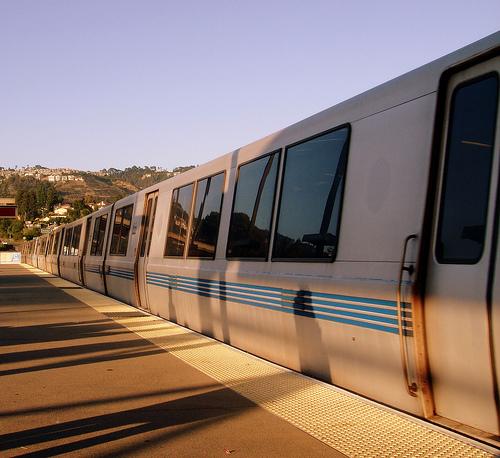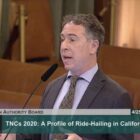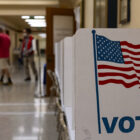For the audio version on KALW News, take a listen: http://kalwnews.org/audio/2010/02/18/how-bart-lost-70-million-federal-grants_167676.html
People are justifiably concerned about where all the federal stimulus money is going. Much of that money is borrowed, so it’s not just our tax dollars at stake — our children will be paying the interest on these projects for years to come. And the rush to create jobs increases the odds that bad projects will be approved.
But at least in some cases, the stimulus is having the opposite effect. Rather than opening the floodgates to frivolous projects, the federal money and the scrutiny that comes with it are forcing states and municipalities to make much-needed changes. KALW-FM reporter Nathanael Johnson has the story of how that happened in the pursuit of one project in the Bay Area.
* * *
The story of the Oakland Airport Connector began some 30 years ago, right about the time BART came online and people started talking about connecting to the Oakland Airport. On Feb. 12 that story came to an end, when the federal government announced that the project wouldn’t be getting any money from them. But that abbreviated story line leaves one huge hanging question: this is just the sort of project that the Obama administration wants to fund — so what went wrong? BART spokesman Linton Johnson says it all has to do with Title VI, the Civil Rights Act.
LINTON JOHNSON: We’ve always complied with Title VI; however, there are these things called circulars which are the nuts and bolts of Title VI, and describes how the policy should be implemented. And the newest circular came out in May of 2007.
It said that before making any changes, transit agencies should do studies to see how higher fares would impact low-income residents.
LINTON JOHNSON: The bottom line is that the circular is a good thing. The information in the circular — it’s going to make BART better.
But BART planners didn’t do the study for this project. They’d already completed most of their planning when the new circular came out, so they assumed it wouldn’t apply to them.
LINTON JOHNSON: You have the outgoing Bush administration and the incoming Obama administration, and one may have kind of said, “Yes, you’re grandfathered in,” and the new one says, “No, we want everything to conform with it.”
It didn’t conform, so it didn’t get the money. That’s exactly what advocates had warned might happen. Back in June, Bob Allen of the nonprofit Urban Habitat pointed out that the connector didn’t comply with the new circular. In response, BART assured elected officials that the connector project was good to go. In a letter, a BART staff attorney wrote, “I am pleased to advise you that BART has prepared the documentation required to satisfy the FTA requirements.” That, simply put, was false.
BART Board member Bob Franklin now knows that Bob Allen was right, and BART was wrong.
BOB FRANKLIN: There was a misinterpretation from BART’s legal department or a misunderstanding — some deficiency that BART didn’t address with the FTA. There’s a willingness to address it, it wasn’t to skirt the issue.
The letter strongly implies that the connector had already satisfied the requirements of the new circular, and BART knew that was not true. A more transparent letter would have explained that BART was operating under the assumption that the new rules just wouldn’t apply to this project.
FRANKLIN: This could have been more forthcoming, I will acknowledge that, you know, to address Mr. Allen’s complaints or why they are not being addressed at this point.
Several board members told KALW they were blindsided by the revelation that the staff had not actually conducted the review. And it wasn’t the first time board members were misled, according to John Knox White, program director for TransForm, one of the nonprofits that has become concerned about the connector.
JOHN KNOX WHITE: Almost all the key metrics that one would use to decide that this was a good project and would need to go forward, we have found have not been presented accurately. We showed that to BART staff, we showed them that their numbers were wrong, and yet they continue.
If you listen to the facts and figures presented by BART, the connector sounds like a good idea. It was supposed to create some 5,000 jobs and carry more than 9,000 people a day. There’s just one problem: a lot of those facts are incorrect. Let’s just take one example: for years, BART has been saying the connector will take what’s currently a 22-minute bus ride and turn it into a 12-minute trip:
LINTON JOHNSON: And that’s including the wait time — that’s including the time you get off BART, wait for the connector, and then walk to the terminal from the connector station at the airport. So 12 minutes on average.
But it’s not 12 minutes. According to BART’s own planning documents, the time is 14 minutes, 30 seconds — and even that is too low. To see how long it would really take, I met John Knox White at the Coliseum BART station. He brought a stopwatch and a pad of paper.
KNOX WHITE: So it’s zeroed out, I’m not gaming the system, so we’ll start here. I was doing this earlier I realized I walk faster than the average person.
NATHANAEL JOHNSON: You have to imagine you are holding your rolling bag.
KNOX WHITE: Exactly.
We walk all the way to the end of the platform — about the length of a football field — that’s where the connector plans called for an escalator to take you to another walkway.
KNOX WHITE: And then you’ll walk another 250 feet to where you’ll get on the train.
It’s a lot farther than the walk down to the existing bus, and yet BART estimates show that passengers will make this walk in a little more than half the time. Next we went to the airport and measured the walk times there. Knox White is obsessive about getting this right. He measures the length of each stoplight and averages the walk times for terminal one and terminal two. The total trip time ends up being 16 minutes, 45 seconds. So the times have gone from 12 minutes, to 14 minutes 30 seconds, to almost 17 minutes. BART’s Linton Johnson says, what’s the big deal?
LINTON JOHNSON: So you walk an extra 10 seconds? I don’t know what the difference is, but it’s going to be negligible. And it’s really going to feel negligible when your bus is stuck behind an accident or a freight train that takes forever or game day traffic — it’s going to feel like you know what? We really should have spent that extra money, because it’s never going to be cheaper than today to build that airport connector.
But Knox White does see a cheaper option: add a couple more buses — give them dedicated lanes in congested spots and priority at lights — and he says it would get you there within seconds of the train. He has elegant solutions for dealing with traffic and freight trains. Instead of costing half a billion dollars, like the train, these improvements would cost one seventh of that, according to TransForm.
Emails obtained through the Public Records Act show that BART was not interested in assessing the merits of this plan. Instead, BART Project Manager Tom Dunscombe sent out an email to consultants writing, “Any information you can provide to put holes in this would be appreciated — we have some worried Board members and I need to easily discredit this ‘paper.’” These sound more like the words of an advocate intent on influencing the decision makers than an impartial public servant, but BART spokesman Linton Johnson says that’s for the good.
LINTON JOHNSON: Listen, BART is an advocate of the projects that we want to build. We got the public buy-in on the project and thus we should be advocating for them.
But Knox White says that BART has used bad information to win that public buy-in. He has documented incidences in which BART statements contradicted their own data when talking about the number of people expected to ride the connector, the number of jobs it would create, the possibility of creating intermediate stops, and the percentage of equipment that would be built in America.
KNOX WHITE: One of the frustrations here is that when over and over and over again we’ve shown that BART’s info they presented to the board is not accurate, the board has taken no action to correct that. And I think as we talk about large-scale planning in the Bay Area, that is a major concern.
In this case, the federal government caught discrepancies that the local government missed. BART Board member Bob Franklin says this sends a strong message and that complying with Title VI will be BART’s number one priority moving forward. But there is another question here — will the BART board do anything to insure that in the future it’s getting the most transparent and impartial information possible from its own staff?
For Crosscurrents, I’m Nathanael Johnson.
* * *
BART did end up getting about $16 of the $70 million for rail and car improvements. The rest of the money will benefit other Bay Area transit agencies. AC transit will get more than $6 million to fix its buses, and San Francisco MUNI will get $17.5 million to revamp its light rail vehicle wheels.









